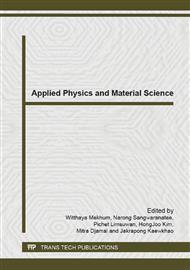[1]
Takeshi Takahashi , Yoshinori Takao, Yugo Ichida , Koji Eriguchi, Kouichi Ono, Microwave-excited microplasma thruster with helium and hydrogen propellants, Physics of Plasma 18 (2011) 063505.
DOI: 10.1063/1.3596539
Google Scholar
[2]
Claire Tendero, Christelle Tixier, Pascal Tristant, Jean Desmaison, Philippe Leprince, Atmospheric pressure plasmas: A review, Spectrochimica Acta Part B 61 (2006) 2 – 30.
DOI: 10.1016/j.sab.2005.10.003
Google Scholar
[3]
Annemie Bogaerts, Erik Neyts, Renaat Gijbels, Joost van der Mullen, Gas discharge plasmas and their applications, Spectrochimica Acta Part B 57 (2002) 609–658.
DOI: 10.1016/s0584-8547(01)00406-2
Google Scholar
[4]
J Hopwood, F Iza, S Coy and D B Fenner, A Microfabricated Atmospheric-pressure Microplasma Source Operating in Air, J. Phys. D: Appl. Phys. 38 (2005) 1698–1703.
DOI: 10.1088/0022-3727/38/11/009
Google Scholar
[5]
Felipe Iza and Jeffrey A. Hopwood, Low-Power Microwave Plasma Source Based on a Microstrip Split-Ring Resonator, Plasma Science, IEEE Transaction on 31 (2003) 782 – 787.
DOI: 10.1109/tps.2003.815470
Google Scholar
[6]
Daibing Luo, Yixiang Duan, Microplasmas for Analytical Applications of Lab-on-a-Chip, Trends in Analytical Chemistry 39 (2012) 254-266.
DOI: 10.1016/j.trac.2012.07.004
Google Scholar
[7]
C. Chaichumporn, P. Ngamsirijit, N. Boonklin, K. Eaiprasetsak and M. Fuangfoong, Design and Construction of 2. 45 GHz Microwave Plasma Source at Atmospheric Pressure, Procedia Engineering 8 (2011) 94–100.
DOI: 10.1016/j.proeng.2011.03.018
Google Scholar
[8]
K. Uomwech, K. Sarapat and P.P. Yupapin, Dynamic Modulated Gaussian Pulse Propagation within the Double PANDA Ring Resonator, Microw. Opt. Technol. Lett. 52 (2010) 1818-1821.
DOI: 10.1002/mop.25315
Google Scholar
[9]
S. Songmuang, S. Punthawanunt, S. Mitathab and P.P. Yupapin, Photon Switching using Nonlinear PANDA Ring Resonetor, Procedia Engineering 8 (2011) 459–466.
DOI: 10.1016/j.proeng.2011.03.084
Google Scholar
[10]
S. Songmuanga, S. Punthawanunt, S. Mitatha and P.P. Yupapin, Multi Light Sources Enhancement using Double PANDA Ring Resonators, Procedia Engineering 8 (2011) 451–458.
DOI: 10.1016/j.proeng.2011.03.083
Google Scholar
[11]
P.P. Yupapin, Nonlinear Coupling Effects of Waves in a PANDA ring, Science Discovery 1 (2013) 1-5.
Google Scholar
[12]
P. Zhao, C. Liao, W. Lin, and J. Feng, Effects of Microwave Frequency on Electron Energy Distribution Function and Air Breakdown Using the Fluid Model, Progress In Electromagnetics Research M 26 (2012) 279-287.
DOI: 10.2528/pierm12101201
Google Scholar


